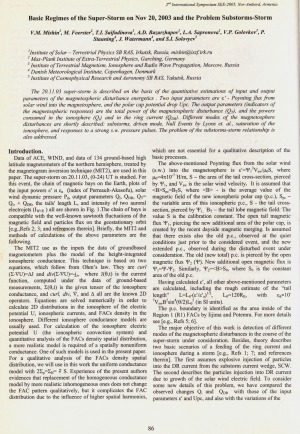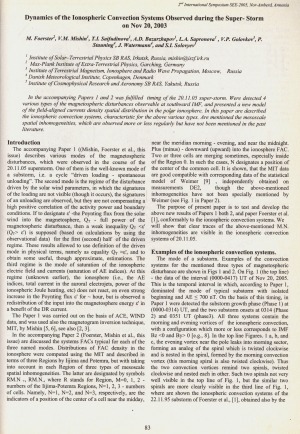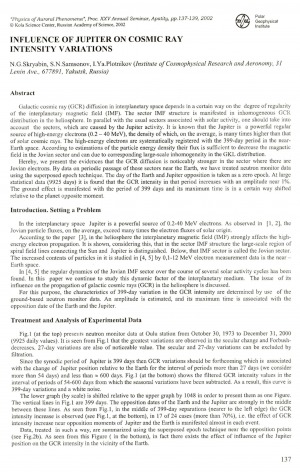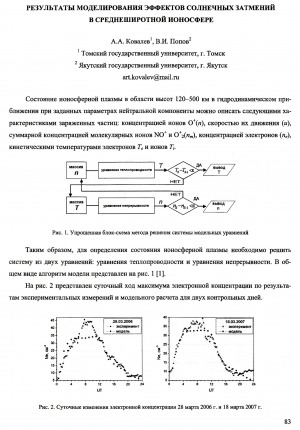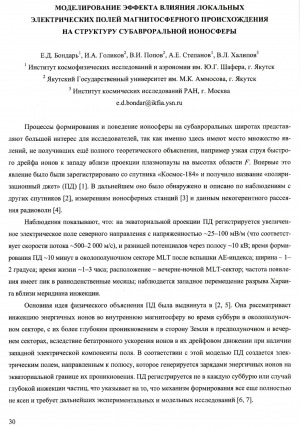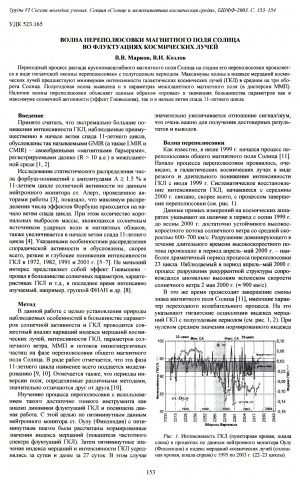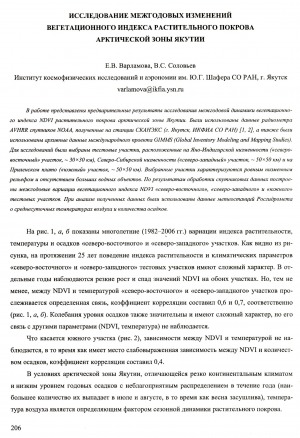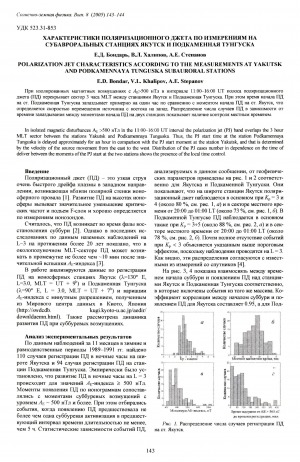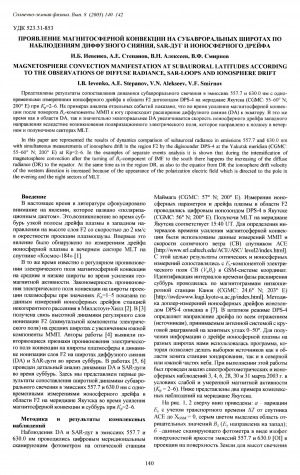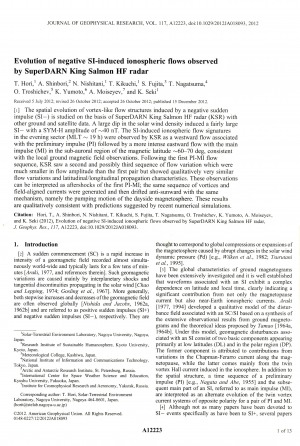Количество страниц: 4 с.
- Математика. Естественные науки > Астрономия. Астрофизика. Исследование космического пространства. Геодезия,
- Математика. Естественные науки > Геология. Геологические и геофизические науки,
- НАУКА ЯКУТИИ > МАТЕМАТИКА. ЕСТЕСТВЕННЫЕ НАУКИ > Астрономия. Астрофизика. Исследование космического пространства. Геодезия,
- НАУКА ЯКУТИИ > МАТЕМАТИКА. ЕСТЕСТВЕННЫЕ НАУКИ > Геология. Геологические и геофизические науки.
Basic Regimes of the Super-Storm on Nov 20, 2003 and the Problems Substorms-Storm / V. M. Mishin, M. Foerster, T. I. Saifudinova, A. D. Bazarzhapov, L. A. Sapronova, V. P. Golovkov, P. Stauning, J. Watermann, and S. I. Solovyev // Solar Extreme Events Fundamental Science and Applied Aspects Nor-Amberd, Armenia 26-30 September 2005 : proceedings of the Second International Symposium / edited by A. Chilingarian and G. Karapetyan. − Erevan : Cosmic Ray Division, Alikhanyan Physics Institute, 2006. − P. 86-89.
Количество страниц: 3 с.
- Математика. Естественные науки > Астрономия. Астрофизика. Исследование космического пространства. Геодезия,
- Математика. Естественные науки > Геология. Геологические и геофизические науки,
- Прикладные науки. Медицина. Ветеринария. Техника. Сельское хозяйство > Инженерное дело. Техника в целом,
- НАУКА ЯКУТИИ > МАТЕМАТИКА. ЕСТЕСТВЕННЫЕ НАУКИ > Астрономия. Астрофизика. Исследование космического пространства. Геодезия,
- НАУКА ЯКУТИИ > ПРИКЛАДНЫЕ НАУКИ. МЕДИЦИНА. ТЕХНИКА. СЕЛЬСКОЕ ХОЗЯЙСТВО > Инженерное дело. Техника в целом,
- НАУКА ЯКУТИИ > МАТЕМАТИКА. ЕСТЕСТВЕННЫЕ НАУКИ > Геология. Геологические и геофизические науки.
Dynamics of the Ionospheric Convection Systems Observed during The Super-Storm on Nov. 20, 2003 / M. Foerster, V. M. Mishin, T. I. Saifudinova, A. D. Bazarzhapov, L. A. Sapronova, V. P. Golovkov, P. Stauning, J. Watermann, and S. I. Solovyev // Solar Extreme Events Fundamental Science and Applied Aspects Nor-Amberd, Armenia 26-30 September 2005 : proceedings of the Second International Symposium / edited by A. Chilingarian and G. Karapetyan. − Erevan : Cosmic Ray Division, Alikhanyan Physics Institute, 2006. − P. 83-85.
Количество страниц: 4 с.
Skryabin, N. G. Influence of Jupiter on cosmic ray intensity variations / N. G. Skryabin, S. N. Samsonov, I. Ya. Plotnikov // Physics of auroral phenomena : proceedings of the 25th annual seminar, Apatity, 26 February – 1 March 2002. – 2002. – P. 137-139.
Количество страниц: 4 с.
Ковалев, А. А. Результаты моделирования эффектов солнечных затмений в среднеширотной ионосфере / А. А. Ковалев, В. И. Попов // Физика окружающей среды : материалы VIII Международной школы молодых ученых. – Томск : ТГУ, 2010. – С. 83-86.
Количество страниц: 4 с.
Моделирование эффекта влияния локальных электрических полей магнитосферного происхождения на структуру субавроральной ионосферы / Е. Д. Бондарь, И. А. Голиков, В. И. Попов, А. Е. Степанов, В. Л. Халипов // Физика окружающей среды : материалы VIII Международной школы молодых ученых. – Томск : ТМЛ-Пресс, 2010. – С. 30-33.
Количество страниц: 2 с.
Марков, В. В. Волна переполюсовки магнитного поля солнца во флуктациях космических лучей / В. В. Марков, В. И. Козлов // Труды VI сессии молодых ученых "Волновые процессы в проблеме космической погоды" [15-20 сентября 2003 г.]. - Иркутск : ИСЗФ, 2003. - С. 150-154.
Количество страниц: 2 с.
Варламова, Е. В. Исследование межгодовых изменений вегетационного индекса растительного покрова арктической зоны Якутии / Е. В. Варламова, В. С. Соловьев // Физика окружающей среды : материалы Всероссийской конференции с международным участием, посвященной 50-летию первого полета человека в космос и 75-летию регулярных исследований ионосферы в России, г. Томск, 27 июня - 1 июля 2011 г. – Томск : ТГУ, 2011. – С. 206-207.
Количество страниц: 2 с.
In isolated magnetic disturbances АЕ >500 нТл in the 11:00-16:00 UT interval the polarization jet (PJ) band overlaps the 3 hour MLT sector between the stations Yakutsk and Podkamennaya Tunguska. Thus, the PJ start time at the station Podkamennaya Tunguska is delayed approximately for an hour in comparison with the PJ start moment at the station Yakutsk, and that is determined by the velocity of the source movement from the east to the west. Distribution of the PJ cases number in dependence on the time of deliver between the moments of the PJ start at the two stations shows the presence of the local time control.
Характеристики поляризационного джета по измерениям на субавроральных станциях Якутск и Подкаменная Тунгуска = Jet characteristics according to the measurements at yakutsk and podkamennaya tunguska subauroral stations / Е. Д. Бондарь, В. Л. Халипов, А. Е. Степанов // Солнечно-земная физика = Solar-Terrestrial Physics. – 2005. – Вып. 8 (121) : Труды Международной конференции "Солнечно-земная физика". – С. 143-144.
Количество страниц: 3 с.
In this paper are represented the results of dynamics comparison of subauroral radiance in emissions 557.7 and 630.0 nm with simultaneous measurements of ionosphere drift in the region F2 by the digisounder DPS-4 at the Yakutsk meridian (CGMC: 55-60° N; 200° E) at Кр=2-6. In the examples of separate events analysis it is shown that during the intensification of magnetosphere convection after the turning of Bz-component of IMF to the south there happens the increasing of the diffuse radiance (DR) to the equator. At the same time as in the region DR, as also to the equator from DR the ionosphere drift velocity of the western direction is increased because of the appearance of the polarization electric field which is directed to the pole in the evening and the night sectors of MLT.
Проявление магнитосферной конвекции на субавроральных широтах по наблюдениям диффузного сияния, SAR-дуг и ионосферного дрейфа = Magnetosphere convection manifestation at subauroral latitudes according to the observations of diffuse radiance, SAR-loops and ionosphere drift / И. Б. Иевенко, А. Е. Степанов, В. Н. Алексеев, В. Ф. Смирнов // Солнечно-земная физика = Solar-Terrestrial Physics. – 2005. – Вып. 8 (121) : Труды Международной конференции "Солнечно-земная физика". – С. 140-142.
Количество страниц: 14 с.
Evolution of negative SI-induced ionospheric flows observed by SuperDARN King Salmon HF radar / T. Hori, A. Shinbori, N. Nishitani, T. Kikuchi, S. Fujita, T. Nagatsuma, O. Troshichev, K. Yumoto, A. Moiseyev, and K. Seki // Journal of Geophysical Research: Space Physics. – 1978. – 2012 (December), vol. 117, N 12. – P. A12223.
DOI: 10.1029/2012JA018093
